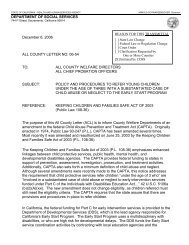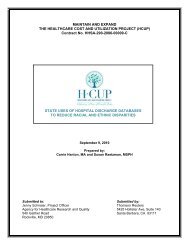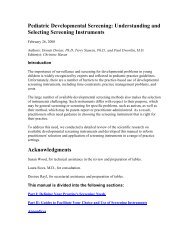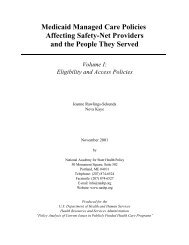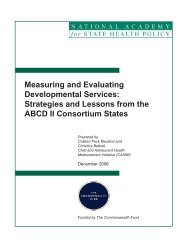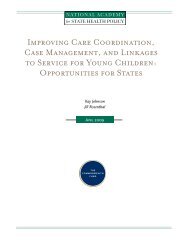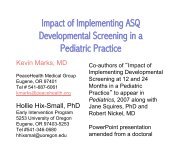Developing Federally Qualified Health Centers into Community ...
Developing Federally Qualified Health Centers into Community ...
Developing Federally Qualified Health Centers into Community ...
Create successful ePaper yourself
Turn your PDF publications into a flip-book with our unique Google optimized e-Paper software.
• Staff are covered by federal malpractice coverage.<br />
• More than 80 percent of patient visits are paid for by commercial, Medicare, or<br />
Medicaid insurance—a much more favorable payer mix than Open Door’s other<br />
FQHC operations, which have a larger proportion of uninsured patients.<br />
• Because urgent care providers do not spend time on lengthy chronic care<br />
consultations, a relatively small number of providers are able to see a relatively large<br />
number of patients. This improves Open Door’s overall productivity.<br />
• Referrals for patients without a usual source of care from the Southway site to Open<br />
Door’s other sites for primary care has resulted in new patients for Open Door and a<br />
more diversified payer mix.<br />
As a result of its positive experience thus far, Open Door is considering opening a<br />
second urgent care site. Looking ahead, Open Door leaders would like to improve<br />
communication between the Southway site and private primary care providers.<br />
Through the Southway site, Open Door has developed strong relationships with<br />
some local private primary care providers. However, its outreach efforts have generally<br />
targeted new patients. It might benefit from further efforts to reach out to community<br />
providers to make them aware of the services provided at Southway.<br />
OPPORTUNITIES AND CHALLENGES TO DEVELOPING FQHC-BASED<br />
NETWORKS TO SUPPORT PRIMARY CARE PRACTICES<br />
Among the stakeholders we interviewed, there was universal agreement that many<br />
primary care practices—particularly small and rural practices—could benefit from having<br />
access to shared support services. <strong>Community</strong> networks, what several described as<br />
―virtual health centers,‖ would enable community providers and FQHCs to share<br />
resources and better meet patient needs. States, too, stand to benefit from developing<br />
community networks that leverage the assets of FQHCs. The Affordable Care Act<br />
provides $11 billion to create new federally funded health centers, providing new<br />
opportunities to partner to better meet delivery system goals.<br />
FQHC–based community networks may be more appropriate in some<br />
communities than in others. In some communities, hospitals, managed care organizations,<br />
large practices, local public health departments, or other organizations—rather than FQHCs—<br />
may be best positioned to efficiently and effectively serve as hubs for sharing services.<br />
The level of leadership, commitment, and willingness to take on a broad mission are key<br />
variables to the success of an organization’s network, while infrastructure is also important.<br />
22



